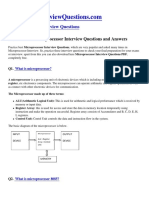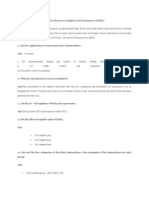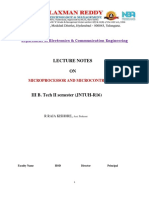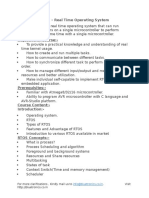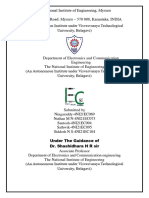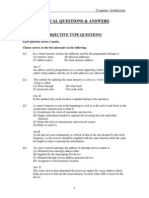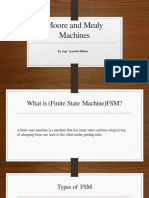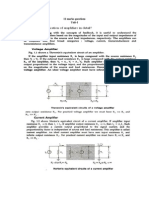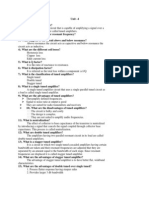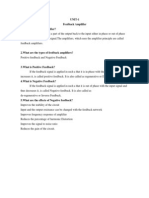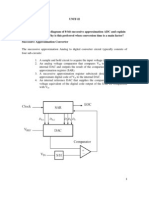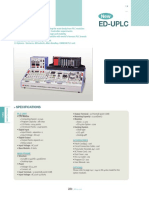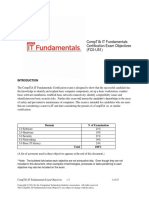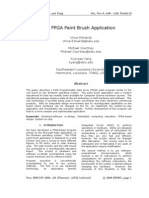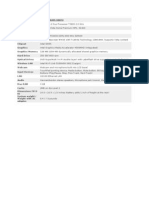Microprocesor 3 Unit
Microprocesor 3 Unit
Uploaded by
Ganapathy RamadossCopyright:
Available Formats
Microprocesor 3 Unit
Microprocesor 3 Unit
Uploaded by
Ganapathy RamadossCopyright
Available Formats
Share this document
Did you find this document useful?
Is this content inappropriate?
Copyright:
Available Formats
Microprocesor 3 Unit
Microprocesor 3 Unit
Uploaded by
Ganapathy RamadossCopyright:
Available Formats
Department of ECE Unit 3 - RGCET
UNIT III
80X86 PROCESSORS
Evolution from 8080/8085 to 8086
Intel introduced 8086 microprocessor in 1978. This 16-bit microprocessor was a major
improvement over the previous generation of 8080/8085 series of microprocessors.
In a system with pipelining, the data and the address bus are busy transferring data
while the CPU is
processing information.
Overview or Features of 8086
It is a 16-bit Microprocessor(μp).It’s ALU, internal registers works with 16bit
binary word.
8086 has a 20 bit address bus can access up to 220= 1 MB memory locations.
8086 has a 16bit data bus. It can read or write data to a memory/port either 16bits
or 8 bit at a time.
It can support up to 64K I/O ports.
It provides 14, 16 -bit registers.
Frequency range of 8086 is 6-10 MHz
It has multiplexed address and data bus AD0- AD15 and A16 – A19.
It requires single phase clock with 33% duty cycle to provide internal timing.
It can prefetch upto 6 instruction bytes from memory and queues them in order to
speed up instruction execution.
It requires +5V power supply.
A 40 pin dual in line package.
8086 is designed to operate in two modes, Minimum mode and Maximum mode.
o The minimum mode is selected by applying logic 1 to the MN / MX#
input pin. This is a single microprocessor configuration.
o The maximum mode is selected by applying logic 0 to the MN / MX#
input pin. This is a multi micro processors configuration.
Microprocessors & Microcontrollers 1
Department of ECE Unit 3 - RGCET
3.1. Architechture of 8086 / Functional Block diagram of 8086
8086 has two blocks Bus Interfacing Unit(BIU) and Execution Unit(EU).
The BIU performs all bus operations such as instruction fetching, reading and
writing operands for memory and calculating the addresses of the memory
operands. The instruction bytes are transferred to the instruction queue.
EU executes instructions from the instruction system byte queue.
Both units operate asynchronously to give the 8086 an overlapping instruction
fetch and execution mechanism which is called as Pipelining. This results in
efficient use of the system bus and system performance.
BIU contains Instruction queue, Segment registers, Instruction pointer, Address
adder.
EU contains Control circuitry, Instruction decoder, ALU, Pointer and Index
register, Flag register.
Explanation of Architechture of 8086
Microprocessors & Microcontrollers 2
Department of ECE Unit 3 - RGCET
BUS INTERFACE UNIT:
It provides a full 16 bit bidirectional data bus and 20 bit address bus.
The bus interface unit is responsible for performing all external bus operations.
Specifically it has the following functions:
Instruction fetch, Instruction queuing, Operand fetch and storage, Address
relocation and Bus control.
The BIU uses a mechanism known as an instruction stream queue to implement a
pipeline architecture.
This queue permits prefetch of up to six bytes of instruction code. When ever the
queue of the BIU is not full, it has room for at least two more bytes and at the
same time the EU is not requesting it to read or write operands from memory, the
BIU is free to look ahead in the program by prefetching the next sequential
instruction.
These prefetching instructions are held in its FIFO queue. With its 16 bit data bus,
the BIU fetches two instruction bytes in a single memory cycle.
After a byte is loaded at the input end of the queue, it automatically shifts up
through the FIFO to the empty location nearest the output.
The EU accesses the queue from the output end. It reads one instruction byte after
the other from the output of the queue. If the queue is full and the EU is not
requesting access to operand in memory.
These intervals of no bus activity, which may occur between bus cycles are
known as Idle state.
If the BIU is already in the process of fetching an instruction when the EU request
it to read or write operands from memory or I/O, the BIU first completes the
instruction fetch bus cycle before initiating the operand read / write cycle.
The BIU also contains a dedicated adder which is used to generate the 20bit
physical address that is output on the address bus. This address is formed by
adding an appended 16 bit segment address and a 16 bit offset address.
For example: The physical address of the next instruction to be fetched is formed
by combining the current contents of the code segment CS register and the current
contents of the instruction pointer IP register.
Microprocessors & Microcontrollers 3
Department of ECE Unit 3 - RGCET
The BIU is also responsible for generating bus control signals such as those for
memory read or write and I/O read or write.
EXECUTION UNIT
The Execution unit is responsible for decoding and executing all instructions.
The EU extracts instructions from the top of the queue in the BIU, decodes them,
generates operands if necessary, passes them to the BIU and requests it to perform
the read or write bys cycles to memory or I/O and perform the operation specified
by the instruction on the operands.
During the execution of the instruction, the EU tests the status and control flags
and updates them based on the results of executing the instruction.
If the queue is empty, the EU waits for the next instruction byte to be fetched and
shifted to top of the queue.
When the EU executes a branch or jump instruction, it transfers control to a
location corresponding to another set of sequential instructions.
Whenever this happens, the BIU automatically resets the queue and then begins to
fetch instructions from this new location to refill the queue.
General purpose registers
The 8086 microprocessor has a total of fourteen registers that are accessible to the
programmer. It is divided into four groups. They are:
Four General purpose registers
Four Index/Pointer registers
Four Segment registers
Two Other registers
General purpose registers :
Microprocessors & Microcontrollers 4
Department of ECE Unit 3 - RGCET
Accumulator register consists of two 8-bit registers AL and AH, which can be combined
together and used as a 16-bit register AX. AL in this case contains the loworder byte of
the word, and AH contains the high-order byte. Accumulator can be used for I/O
operations and string manipulation.
Base register consists of two 8-bit registers BL and BH, which can be combined together
and used as a 16-bit register BX. BL in this case contains the low-order byte of the word,
and BH contains the high-order byte. BX register usually contains a data pointer used for
based, based indexed or register indirect addressing.
Count register consists of two 8-bit registers CL and CH, which can be combined
together and used as a 16-bit register CX. When combined, CL register contains the
loworder byte of the word, and CH contains the high-order byte. Count register can be
used in Loop, shift/rotate instructions and as a counter in string manipulation
Data register consists of two 8-bit registers DL and DH, which can be combined together
and used as a 16-bit register DX. When combined, DL register contains the low order
byte of the word, and DH contains the high-order byte. Data register can be used as a port
number in I/O operations. In integer 32-bit multiply and divide instruction the DX
register contains high-order word of the initial or resulting number.
3.2. Pin Diagram of 8086 and Pin description of 8086
Figure shows the Pin diagram of 8086. The description follows it.
Microprocessors & Microcontrollers 5
Department of ECE Unit 3 - RGCET
The Microprocessor 8086 is a 16-bit CPU available in different clock rates and
packaged in a 40 pin CERDIP or plastic package.
The 8086 operates in single processor or multiprocessor configuration to achieve
high performance. The pins serve a particular function in minimum mode (single
processor mode ) and other function in maximum mode configuration
(multiprocessor mode ).
The 8086 signals can be categorised in three groups.
o The first are the signal having common functions in minimum as well as
maximum mode.
o The second are the signals which have special functions for minimum
mode
o The third are the signals having special functions for maximum mode.
The following signal descriptions are common for both modes.
AD15-AD0 : These are the time multiplexed memory I/O address and data lines.
o Address remains on the lines during T1 state, while the data is available on
the data bus during T2, T3, Tw and T4. These lines are active high and
float to a tristate during interrupt acknowledge and local bus hold
acknowledge cycles.
Microprocessors & Microcontrollers 6
Department of ECE Unit 3 - RGCET
A19/S6,A18/S5,A17/S4,A16/S3 : These are the time multiplexed address and
status lines.
o During T1 these are the most significant address lines for memory
operations.
o During I/O operations, these lines are low.
o During memory or I/O operations, status information is available on those
lines for T2,T3,Tw and T4.
o The status of the interrupt enable flag bit is updated at the beginning of
each clock cycle.
o The S4 and S3 combinely indicate which segment register is presently
being used for memory accesses as in below fig.
o These lines float to tri-state off during the local bus hold acknowledge.
The status line S6 is always low.
o The address bit are separated from the status bit using latches controlled
by the ALE signal.
S4 S3 Indication
0 0 Alternate Data
0 1 Stack
1 0 Code or None
1 1 Data
0 0 Whole word
0 1 Upper byte from or to even address
1 0 Lower byte from or to even address
BHE/S7 : The bus high enable is used to indicate the transfer of data over the
higher order ( D15-D8 ) data bus as shown in table. It goes low for the data
transfer over D15-D8 and is used to derive chip selects of odd address memory
bank or peripherals. BHE is low during T1 for read, write and interrupt
acknowledge cycles, whenever a byte is to be transferred on higher byte of data
bus. The status information is available during T2, T3 and T4. The signal is active
Microprocessors & Microcontrollers 7
Department of ECE Unit 3 - RGCET
low and tristated during hold. It is low during T1 for the first pulse of the interrupt
acknowledge cycle.
RD – Read : This signal on low indicates the peripheral that the processor is
performing memory or I/O read operation. RD is active low and shows the state
for T2, T3, Tw of any read cycle. The signal remains tristated during the hold
acknowledge.
READY : This is the acknowledgement from the slow device or memory that
they have completed the data transfer. The signal made available by the devices is
synchronized by the 8284A clock generator to provide ready input to the 8086.
the signal is active high.
INTR-Interrupt Request : This is a triggered input. This is sampled during the
last clock cycles of each instruction to determine the availability of the request. If
any interrupt request is pending, the processor enters the interrupt acknowledge
cycle. This can be internally masked by resulting the interrupt enable flag. This
signal is active high and internally synchronized.
TEST : This input is examined by a ‘WAIT’ instruction. If the TEST pin goes
low, execution will continue, else the processor remains in an idle state. The input
is synchronized internally during each clock cycle on leading edge of clock.
CLK- Clock Input : The clock input provides the basic timing for processor
operation and bus control activity. Its an asymmetric square wave with 33% duty
cycle.
Figure shows the Pin functions of 8086.
Microprocessors & Microcontrollers 8
Department of ECE Unit 3 - RGCET
The following pin functions are for the minimum mode operation of 8086.
M/IO – Memory/IO : This is a status line logically equivalent to S2 in maximum
mode. When it is low, it indicates the CPU is having an I/O operation, and when it
is high, it indicates that the CPU is having a memory operation. This line becomes
active high in the previous T4 and remains active till final T4 of the current cycle.
It is tristated during local bus “hold acknowledge “.
INTA – Interrupt Acknowledge : This signal is used as a read strobe for
interrupt acknowledge cycles. i.e. when it goes low, the processor has accepted
the interrupt.
ALE – Address Latch Enable : This output signal indicates the availability of
the valid address on the address/data lines, and is connected to latch enable input
of latches. This signal is active high and is never tristated.
DT/R – Data Transmit/Receive: This output is used to decide the direction of
data flow through the transreceivers (bidirectional buffers). When the processor
Microprocessors & Microcontrollers 9
Department of ECE Unit 3 - RGCET
sends out data, this signal is high and when the processor is receiving data, this
signal is low.
DEN – Data Enable : This signal indicates the availability of valid data over the
address/data lines. It is used to enable the transreceivers ( bidirectional buffers ) to
separate the data from the multiplexed address/data signal. It is active from the
middle of T2 until the middle of T4. This is tristated during ‘ hold acknowledge’
cycle.
HOLD, HLDA- Acknowledge : When the HOLD line goes high, it indicates to
the processor that another master is requesting the bus access. The processor, after
receiving the HOLD request, issues the hold acknowledge signal on HLDA pin, in
the middle of the next clock cycle after completing the current bus cycle.
At the same time, the processor floats the local bus and control lines. When the
processor detects the HOLD line low, it lowers the HLDA signal. HOLD is an
asynchronous input, and is should be externally synchronized. If the DMA request
is made while the CPU is performing a memory or I/O cycle, it will release the
local bus during T4 provided :
1.The request occurs on or before T2 state of the current cycle.
2.The current cycle is not operating over the lower byte of a word.
3.The current cycle is not the first acknowledge of an interrupt acknowledge sequence.
4. A Lock instruction is not being executed.
The following pin functions are applicable for maximum mode operation of 8086.
S2, S1, S0 – Status Lines : These are the status lines which reflect the type of
operation, being carried out by the processor. These become activity during T4 of
the previous cycle and active during T1 and T2 of the current bus cycles.
LOCK : This output pin indicates that other system bus master will be prevented
fromgaining the system bus, while the LOCK signal is low. The LOCK signal is
activated by the ‘LOCK’ prefix instruction and remains active until the
completion of the next instruction. When the CPU is executing a critical
Microprocessors & Microcontrollers 10
Department of ECE Unit 3 - RGCET
instruction which requires the system bus, the LOCK prefix instruction ensures
that other processors connected in the system will not gain the control of the bus.
The 8086, while executing the prefixed instruction, asserts the bus lock signal output,
which may be connected to an external bus controller. By prefetching the instruction,
there is a considerable speeding up in instruction execution in 8086. This is known as
instruction pipelining.
S2 S1 S0 Indication
0 0 0 Interrupt Acknowledge
0 0 1 Read I/O port
0 1 0 Write I/O port
0 1 1 Halt
1 0 0 Code Access
1 0 1 Read Memory
1 1 0 Write Memory
1 1 1 Passive
At the starting the CS:IP is loaded with the required address from which the
execution is to be started. Initially, the queue will be empty an the microprocessor
starts a fetch operation to bring one byte (the first byte) of instruction code, if the
CS:IP address is odd or two bytes at a time, if the CS:IP address is even.
The first byte is a complete opcode in case of some instruction (one byte opcode
instruction) and is a part of opcode, in case of some instructions ( two byte opcode
instructions), the remaining part of code lie in second byte.
The second byte is then decoded in continuation with the first byte to decide the
instruction length and the number of subsequent bytes to be treated as instruction
data. The queue is updated after every byte is read from the queue but the fetch
cycle is initiated by BIU only if at least two bytes of the queue are empty and the
EU may be concurrently executing the fetched instructions.
Microprocessors & Microcontrollers 11
Department of ECE Unit 3 - RGCET
The next byte after the instruction is completed is again the first opcode byte of
the next instruction. A similar procedure is repeated till the complete execution of
the program. The fetch operation of the next instruction is overlapped with the
execution of the current instruction. As in the architecture, there are two separate
units, namely Execution unit and Bus interface unit.
While the execution unit is busy in executing an instruction, after it is completely
decoded, the bus interface unit may be fetching the bytes of the next instruction
from memory, depending upon the queue status.
QS1 QS0 Indication
0 0 No Operation
0 1 First Byte of the opcode from the queue
1 0 Empty Queue
1 1 Subsequent Byte from the Queue
RQ/GT0, RQ/GT1 – Request/Grant : These pins are used by the other local bus
master in maximum mode, to force the processor to release the local bus at the
end of the processor current bus cycle.
Each of the pin is bidirectional with RQ/GT0 having higher priority than
RQ/GT1. RQ/GT pins have internal pull-up resistors and may be left
unconnected. Request/Grant sequence is as follows:
1.A pulse of one clock wide from another bus master requests the bus access to 8086.
2.During T4(current) or T1(next) clock cycle, a pulse one clock wide from 8086 to the
requesting master, indicates that the 8086 has allowed the local bus to float and that it
will enter the ‘hold acknowledge’ state at next cycle. The CPU bus interface unit is likely
to be disconnected from the local bus of the system.
3.A one clock wide pulse from the another master indicates to the 8086 that the hold
request is about to end and the 8086 may regain control of the local bus at the next clock
cycle. Thus each master to master exchange of the local bus is a sequence of 3 pulses.
There must be at least one dead clock cycle after each bus exchange. The request and
grant pulses are active low.For the bus request those are received while 8086 is
Microprocessors & Microcontrollers 12
Department of ECE Unit 3 - RGCET
performing memory or I/O cycle, the granting of the bus is governed by the rules as in
case of HOLD and HLDA in minimum mode.
3.3. Maximum Mode 8086 System
In the maximum mode, the 8086 is operated by strapping the MN/MX pin to
ground.
In this mode, the processor derives the status signal S2, S1, S0. Another chip
called bus controller derives the control signal using this status information .
In the maximum mode, there may be more than one microprocessor in the system
configuration.
The components in the system are same as in the minimum mode system.
The basic function of the bus controller chip IC8288, is to derive control signals
like RD and WR ( for memory and I/O devices), DEN, DT/R, ALE etc. using the
information by the processor on the status lines.
The bus controller chip has input lines S2, S1, S0 and CLK. These inputs to 8288
are driven by CPU.
It derives the outputs ALE, DEN, DT/R, MRDC, MWTC, AMWC, IORC, IOWC
and AIOWC. The AEN, IOB and CEN pins are specially useful for
multiprocessor systems.
Microprocessors & Microcontrollers 13
Department of ECE Unit 3 - RGCET
AEN and IOB are generally grounded. CEN pin is usually tied to +5V. The
significance of the MCE/PDEN output depends upon the status of the IOB pin.
If IOB is grounded, it acts as master cascade enable to control cascade 8259A,
else it acts as peripheral data enable used in the multiple bus configurations.
INTA pin used to issue two interrupt acknowledge pulses to the interrupt
controller or to an interrupting device.
IORC, IOWC are I/O read command and I/O write command signals respectively.
These signals enable an IO interface to read or write the data from or to the
address port.
The MRDC, MWTC are memory read command and memory write command
signals respectively and may be used as memory read or write signals.
All these command signals instructs the memory to accept or send data from or to
the bus.
For both of these write command signals, the advanced signals namely AIOWC
and AMWTC are available.
Microprocessors & Microcontrollers 14
Department of ECE Unit 3 - RGCET
Here the only difference between in timing diagram between minimum mode and
maximum mode is the status signals used and the available control and advanced
command signals.
R0, S1, S2 are set at the beginning of bus cycle.8288 bus controller will output a
pulse as on the ALE and apply a required signal to its DT / R pin during T1.
In T2, 8288 will set DEN=1 thus enabling transceivers, and for an input it will
activate MRDC or IORC. These signals are activated until T4. For an output, the
AMWC or AIOWC is activated from T2 to T4 and MWTC or IOWC is activated
from T3 to T4.
The status bit S0 to S2 remains active until T3 and become passive during T3 and
T4.
If reader input is not activated before T3, wait state will be inserted between T3
and T4.
3.4. Minimum Mode 8086 System
In a minimum mode 8086 system, the microprocessor 8086 is operated in
minimum mode by strapping its MN/MX pin to logic 1.
In this mode, all the control signals are given out by the microprocessor chip
itself.There is a single microprocessor in the minimum mode system.
The remaining components in the system are latches, transreceivers, clock
generator, memory and I/O devices. Some type of chip selection logic may be
required for selecting memory or I/O devices, depending upon the address map of
the system.
Latches are generally buffered output D-type flip-flops like 74LS373 or 8282.
They are used for separating the valid address from the multiplexed address/data
signals and are controlled by the ALE signal generated by 8086.
Transreceivers are the bidirectional buffers and some times they are called as data
amplifiers. They are required to separate the valid data from the time multiplexed
address/data signals.
They are controlled by two signals namely, DEN and DT/R.
Microprocessors & Microcontrollers 15
Department of ECE Unit 3 - RGCET
The DEN signal indicates the direction of data, i.e. from or to the processor. The
system contains memory for the monitor and users program storage.
Usually, EPROM are used for monitor storage, while RAM for users program
storage. A system may contain I/O devices.
RQ/GT Timings in Maximum Mode
The request/grant response sequence contains a series of three pulses. The
request/grant pins are checked at each rising pulse of clock input.
When a request is detected and if the condition for HOLD request is satisfied, the
processor issues a grant pulse over the RQ/GT pin immediately during T4
(current) or T1 (next) state.
When the requesting master receives this pulse, it accepts the control of the bus, it
sends a release pulse to the processor using RQ/GT pin.
Maximum Mode Interface
When the 8086 is set for the maximum-mode configuration, it provides signals for
implementing a multiprocessor / coprocessor system environment.
By multiprocessor environment we mean that one microprocessor exists in the
system and that each processor is executing its own program.
Usually in this type of system environment, there are some system resources that
are common to all processors.They are called as global resources. There are also
Microprocessors & Microcontrollers 16
Department of ECE Unit 3 - RGCET
other resources that are assigned to specific processors. These are known as local
or private resources.
Coprocessor also means that there is a second processor in the system. In this two
processor does not access the bus at the same time. One passes the control of the
system bus to the other and then may suspend its operation.
In the maximum-mode 8086 system, facilities are provided for implementing
allocation of global resources and passing bus control to other microprocessor or
coprocessor.
8288 Bus Controller – Bus Command and Control Signals:
8086 does not directly provide all the signals that are required to control the
memory, I/O and interrupt interfaces.
Microprocessors & Microcontrollers 17
Department of ECE Unit 3 - RGCET
Specially the WR, M/IO, DT/R, DEN, ALE and INTA, signals are no longer
produced by the 8086. Instead it outputs three status signals S0, S1, S2 prior to the
initiation of each bus cycle. This 3- bit bus status code identifies which type of
bus cycle is to follow.
S2S1S0 are input to the external bus controller device, the bus controller
generates the appropriately timed command and control signals.
S2 S1 S0 Indication 8288 Command
0 0 0 Interrupt Acknowledge INTA
0 0 1 Read I/O port IORC
0 1 0 Write I/O port IOWC , AIOWC
0 1 1 Halt None
1 0 0 Instruction Fetch MRDC
1 0 1 Read Memory MRDC
1 1 0 Write Memory MWTC, AMWC
1 1 1 Passive None
The 8288 produces one or two of these eight command signals for each bus
cycles. For instance, when the 8086 outputs the code S2S1S0 equals 001, it
indicates that an I/O read cycle is to be performed.
In the code 111 is output by the 8086, it is signaling that no bus activity is to take
place.
The control outputs produced by the 8288 are DEN, DT/R and ALE. These 3
signals provide the same functions as those described for the minimum system
mode. This set of bus commands and control signals is compatible with the
Multibus and industry standard for interfacing microprocessor systems.
The output of 8289 are bus arbitration signals:
Bus busy (BUSY), common bus request (CBRQ), bus priority out (BPRO), bus
priority in (BPRN), bus request (BREQ) and bus clock (BCLK).
Microprocessors & Microcontrollers 18
Department of ECE Unit 3 - RGCET
They correspond to the bus exchange signals of the Multibus and are used to lock
other processor off the system bus during the execution of an instruction by the
8086.
In this way the processor can be assured of uninterrupted access to common
system resources such as global memory.
Queue Status Signals : Two new signals that are produced by the 8086 in the
maximum-mode system are queue status outputs QS0 and QS1. Together they
form a 2-bit ueue status code, QS1QS0.
Following table shows the four different queue status.
QS1 QS0 Queue Status
Queue Empty. The queue has been reinitialized as a
0 (low) 0
result of the execution of a transfer instruction.
First Byte. The byte taken from the queue was the first
0 1
byte of the instruction.
Queue Empty. The queue has been reinitialized as a
1 0
result of the execution of a transfer instruction.
Subsequent Byte. The byte taken from the queue was a
1 1
subsequent byte of the instruction.
Table - Queue status codes
Local Bus Control Signal – Request / Grant Signals: In a maximum mode
configuration, the minimum mode HOLD, HLDA interface is also changed.
These two are replaced by request/grant lines RQ/ GT0 and RQ/ GT1,
respectively. They provide a prioritized bus access mechanism for accessing the
local bus.
Microprocessors & Microcontrollers 19
Department of ECE Unit 3 - RGCET
Memory Read Timing Diagram in Maximum Mode of 8086
Memory Write Timing in Maximum mode of 8086
Microprocessors & Microcontrollers 20
Department of ECE Unit 3 - RGCET
Minimum Mode Interface
When the Minimum mode operation is selected, the 8086 provides all control
signals needed to implement the memory and I/O interface.
The minimum mode signal can be divided into the following basic groups :
1. Address/data bus
2. Status
3. Control
4. Interrupt and
5. DMA.
Each and every group is explained clearly.
Address/Data Bus :
These lines serve two functions. As an address bus is 20 bits long and consists of
signal lines A0 through A19. A19 represents the MSB and A0 LSB. A 20bit
address gives the 8086 a 1Mbyte memory address space. More over it has an
independent I/O address space which is 64K bytes in length.
The 16 data bus lines D0 through D15 are actually multiplexed with address lines
A0 through A15 respectively. By multiplexed we mean that the bus work as an
address bus during first machine cycle and as a data bus during next machine
cycles.
D15 is the MSB and D0 LSB. When acting as a data bus, they carry read/write
data for memory, input/output data for I/O devices, and interrupt type codes from
an interrupt controller.
Microprocessors & Microcontrollers 21
Department of ECE Unit 3 - RGCET
Status signal:
The four most significant address lines A19 through A16 are also multiplexed but
in this case with status signals S6 through S3. These status bits are output on the
bus at the same time that data are transferred over the other bus lines.
Bit S4 and S3 together from a 2 bit binary code that identifies which of the 8086
internal segment registers are used to generate the physical address that was
output on the address bus during the current bus cycle.Code S4S3 = 00 identifies
a register known as extra segment register as the source of the segment address.
Status line S5 reflects the status of another internal characteristic of the 8086. It is
the logic level of the internal enable flag. The last status bit S6 is always at the
logic 0 level.
S4 S3 Segment Register
0 0 Extra
0 1 Stack
Microprocessors & Microcontrollers 22
Department of ECE Unit 3 - RGCET
1 0 Code / none
1 1 Data
Memory segment status codes
Control Signals :
The control signals are provided to support the 8086 memory I/O interfaces. They
control functions such as when the bus is to carry a valid address in which
direction data are to be transferred over the bus, when valid write data are on the
bus and when to put read data on the system bus.
ALE is a pulse to logic 1 that signals external circuitry when a valid address word
is on the bus. This address must be latched in external circuitry on the 1-to-0 edge
of the pulse at ALE.
Another control signal that is produced during the bus cycle is BHE bank high
enable. Logic 0 on this used as a memory enable signal for the most significant
byte half of the data bus D8 through D1. These lines also serves a second
function, which is as the S7 status line.
Using the M/IO and DT/R lines, the 8086 signals which type of bus cycle is in
progress and in which direction data are to be transferred over the bus. The logic
level of M/IO tells external circuitry whether a memory or I/O transfer is taking
place over the bus. Logic 1 at this output signals a memory operation and logic 0
an I/O operation.
The direction of data transfer over the bus is signaled by the logic level output at
DT/R. When this line is logic 1 during the data transfer part of a bus cycle, the
bus is in the transmit mode. Therefore, data are either written into memory or
output to an I/O device. On the other hand, logic 0 at DT/R signals that the bus is
in the receive mode. This corresponds to reading data from memory or input of
data from an input port.
Microprocessors & Microcontrollers 23
Department of ECE Unit 3 - RGCET
The signal read RD and write WR indicates that a read bus cycle or a write bus
cycle is in progress. The 8086 switches WR to logic 0 to signal external device
that valid write or output data are on the bus.
On the other hand, RD indicates that the 8086 is performing a read of data of the
bus. During read operations, one other control signal is also supplied. This is DEN
( data enable) and it signals external devices when they should put data on the
bus. There is one other control signal that is involved with the memory and I/O
interface. This is the READY signal.
READY signal is used to insert wait states into the bus cycle such that it is
extended by a number of clock periods. This signal is provided by an external
clock generator device and can be supplied by the memory or I/O sub-system to
signal the 8086 when they are ready to permit the data transfer to be completed.
Interrupt signals :
The key interrupt interface signals are interrupt request (INTR) and interrupt
acknowledge ( INTA).
INTR is an input to the 8086 that can be used by an external device to signal that
it need to be serviced.
Logic 1 at INTR represents an active interrupt request. When an interrupt request
has been recognized by the 8086, it indicates this fact to external circuit with
pulse to logic 0 at the INTA output.
The TEST input is also related to the external interrupt interface. Execution of a
WAIT instruction causes the 8086 to check the logic level at the TEST input.
If the logic 1 is found, the MPU suspend operation and goes into the idle state.
The 8086 no longer executes instructions, instead it repeatedly checks the logic
level of the TEST input waiting for its transition back to logic 0.
As TEST switches to 0, execution resume with the next instruction in the
program. This feature can be used to synchronize the operation of the 8086 to an
event in external hardware.
There are two more inputs in the interrupt interface: the nonmaskable interrupt
NMI and the reset interrupt RESET.
Microprocessors & Microcontrollers 24
Department of ECE Unit 3 - RGCET
On the 0-to-1 transition of NMI control is passed to a nonmaskable interrupt
service routine. The RESET input is used to provide a hardware reset for the
8086. Switching RESET to logic 0 initializes the internal register of the 8086 and
initiates a reset service routine.
DMA Interface signals :
The direct memory access DMA interface of the 8086 minimum mode consist of
the HOLD and HLDA signals.
When an external device wants to take control of the system bus, it signals to the
8086 by switching HOLD to the logic 1 level. At the completion of the current
bus cycle, the 8086 enters the hold state. In the hold state, signal lines AD0
through AD15, A16/S3 through A19/S6, BHE, M/IO, DT/R, RD, WR, DEN and
INTR are all in the high Z state.
The 8086 signals external device that it is in this state by switching its HLDA
output to logic 1 level.
General Bus Operation
The 8086 has a combined address and data bus commonly referred as a time
multiplexed address and data bus.
The main reason behind multiplexing address and data over the same pins is the
maximum utilisation of processor pins and it facilitates the use of 40 pin standard
DIP package.
The bus can be demultiplexed using a few latches and transreceivers, when ever
required.
Basically, all the processor bus cycles consist of at least four clock cycles. These
are referred to as T1, T2, T3, T4. The address is transmitted by the processor
during T1. It is present on the bus only for one cycle.
The negative edge of this ALE pulse is used to separate the address and the data
or status information. In maximum mode, the status lines S0, S1 and S2 are used
to indicate the type of operation.
Status bits S3 to S7 are multiplexed with higher order address bits and the BHE
signal. Address is valid during T1 while status bits S3 to S7 are valid during T2
through T4.
Microprocessors & Microcontrollers 25
Department of ECE Unit 3 - RGCET
Maximum mode
In the maximum mode, the 8086 is operated by strapping the MN/MX pin to
ground.
In this mode, the processor derives the status signal S2, S1, S0. Another chip
called bus controller derives the control signal using this status information .
In the maximum mode, there may be more than one microprocessor in the system
configuration.
Minimum mode
In a minimum mode 8086 system, the microprocessor 8086 is operated in
minimum mode by strapping its MN/MX pin to logic 1.
In this mode, all the control signals are given out by the microprocessor chip
itself.
There is a single microprocessor in the minimum mode system.
Bus Request and Bus Grant Timings in Minimum Mode System of 8086
Microprocessors & Microcontrollers 26
Department of ECE Unit 3 - RGCET
Hold Response sequence: The HOLD pin is checked at leading edge of each clock
pulse. If it is received active by the processor before T4 of the previous cycle or
during T1 state of the current cycle, the CPU activates HLDA in the next clock
cycle and for succeeding bus cycles, the bus will be given to another requesting
master.
The control of the bus is not regained by the processor until the requesting master
does not drop the HOLD pin low. When the request is dropped by the requesting
master, the HLDA is dropped by the processor at the trailing edge of the next
clock.
Write Cycle Timing Diagram for Minimum Mode
The working of the minimum mode configuration system can be better described
in terms of the timing diagrams rather than qualitatively describing the operations.
The opcode fetch and read cycles are similar. Hence the timing diagram can be
categorized in two parts, the first is the timing diagram for read cycle and the
second is the timing diagram for write cycle.
Microprocessors & Microcontrollers 27
Department of ECE Unit 3 - RGCET
The read cycle begins in T1 with the assertion of address latch enable (ALE)
signal and also M / IO signal. During the negative going edge of this signal, the
valid address is latched on the local bus.
The BHE and A0 signals address low, high or both bytes. From T1 to T4 , the
M/IO signal indicates a memory or I/O operation.
At T2, the address is removed from the local bus and is sent to the output. The bus
is then tristated. The read (RD) control signal is also activated in T2.
The read (RD) signal causes the address device to enable its data bus drivers.
After RD goes low, the valid data is available on the data bus.
The addressed device will drive the READY line high. When the processor
returns the read signal to high level, the addressed device will again tristate its bus
drivers.
A write cycle also begins with the assertion of ALE and the emission of the
address. The M/IO signal is again asserted to indicate a memory or I/O operation.
Microprocessors & Microcontrollers 28
Department of ECE Unit 3 - RGCET
In T2, after sending the address in T1, the processor sends the data to be written to
the addressed location.
The data remains on the bus until middle of T4 state. The WR becomes active at
the beginning of T2 (unlike RD is somewhat delayed in T2 to provide time for
floating).
The BHE and A0 signals are used to select the proper byte or bytes of memory or
I/O word to be read or write.
The M/IO, RD and WR signals indicate the type of data transfer as specified in
table below.
3.5. Addressing Modes of 8086
Definition: An instruction acts on any number of operands.The way an instruction
accesses its operands is called its Addressing modes.
Operands may be of three types :
o Implicit
o Explicit
o Both Implicit and Explicit.
Implicit operands mean that the instruction by definition has some specific operands.
The programmers do NOT select these operands.
Example: Implicit operands
XLAT ; automatically takes AL and BX as
operands
AAM ; it operates on the contents of AX.
Explicit operands mean the instruction operates on the operands specified by the
programmer.
Example: Explicit operands
MOV AX, BX; it takes AX and BX as
Microprocessors & Microcontrollers 29
Department of ECE Unit 3 - RGCET
operands
XCHG SI, DI; it takes SI and DI as operands
Implicit and explicit operands
Example: Implicit/Explicit operands
MUL BX; automatically multiply BX explicitly times
AX
The location of an operand value in memory space is called the Effective Address (EA)
We can classify the addressing modes of 8086 into four groups:
Immediate addressing
Register addressing
Memory addressing
I/O port addressing
The first three Addresssing modes are clearly explained.
Immediate addressing mode & Register addressing mode
Immediate Addressing Mode
In this addressing mode, the operand is stored as part of the instruction. The immediate
operand, which is stored along with the instruction, resides in the code segment -- not in
the data segment. This addressing mode is also faster to execute an instruction because
the operand is read with the instruction from memory. Here are some examples:
Example: Immediate Operands
MOV AL, 20 ; move the constant 20 into register AL
ADD AX, 5 ; add constant 5 to register EAX
MOV DX, offset msg ; move the address of message to
register DX
Register addressing mode
In this addressing mode, the operands may be:
Microprocessors & Microcontrollers 30
Department of ECE Unit 3 - RGCET
reg16: 16-bit general registers: AX, BX, CX, DX, SI, DI, SP or BP.
reg8 : 8-bit general registers: AH, BH, CH, DH, AL, BL, CL, or DL.
Sreg : segment registers: CS, DS, ES, or SS. There is an exception: CS cannot be
a destination.
For register addressing modes, there is no need to compute the effective address. The
operand is in a register and to get the operand there is no memory access involved.
Example: Register Operands
MOV AX, BX ; mov reg16, reg16
ADD AX, SI ; add reg16, reg16
MOV DS, AX ; mov Sreg, reg16
Some rules in register addressing modes:
1. You may not specify CS as the destination operand.
Example: mov CS, 02h –> wrong
2. Only one of the operands can be a segment register. You cannot move data from one
segment register to another with a single mov instruction. To copy the value of cs to ds,
you would have to use some sequence like:
mov ds,cs -> wrong
mov ax, cs
mov ds, ax -> the way we do it
You should never use the segment registers as data registers to hold arbitrary values.
They should only contain segment addresses.
Memory Addressing Modes
Memory (RAM) is the main component of a computer to store temporary data and
machine instructions. In a program, programmers many times need to read from and
write into memory locations.
There are different forms of memory addressing modes
Microprocessors & Microcontrollers 31
Department of ECE Unit 3 - RGCET
1. Direct Addressing
2. Register indirect addressing
3. Based addressing
4. Indexed addressing
5. Based indexed addressing
6. Based indexed with displacement
Direct Addressing Mode & Register Indirect Addressing Mode
Direct Addressing Mode
The instruction mov al,ds:[8088h] loads the AL register with a copy of the byte at
memory location 8088h. Likewise, the instruction mov ds:[1234h],dl stores the value in
the dl register to memory location 1234h. By default, all displacement-only values
provide offsets into the data segment. If you want to provide an offset into a different
segment, you must use a segment override prefix before your address. For example, to
access location 1234h in the extra segment (es) you would use an instruction of the form
mov ax,es:[1234h]. Likewise, to access this location in the code segment you would use
the instruction mov ax, cs:[1234h]. The ds: prefix in the previous examples is not a
segment override.
Microprocessors & Microcontrollers 32
Department of ECE Unit 3 - RGCET
The instruction mov al,ds:[8088h] is same as mov al, [8088h]. If not mentioned DS
register is taken by default.
Register Indirect Addressing Mode
The 80x86 CPUs let you access memory indirectly through a register using the register
indirect addressing modes. There are four forms of this addressing mode on the 8086,
best demonstrated by the following instructions:
mov al, [bx]
mov al, [bp]
mov al, [si]
mov al, [di]
Code Example
MOV BX, 100H
MOV AL, [BX]
The [bx], [si], and [di] modes use the ds segment by default. The [bp] addressing mode
uses the stack segment (ss) by default. You can use the segment override prefix symbols
if you wish to access data in different segments. The following instructions demonstrate
the use of these overrides:
mov al, cs:[bx]
mov al, ds:[bp]
mov al, ss:[si]
mov al, es:[di]
Intel refers to [bx] and [bp] as base addressing modes and bx and bp as base registers (in
fact, bp stands for base pointer). Intel refers to the [si] and [di] addressing modes as
indexed addressing modes (si stands for source index, di stands for destination index).
However, these addressing modes are functionally equivalent. This text will call these
forms register indirect modes to be consistent.
Microprocessors & Microcontrollers 33
Department of ECE Unit 3 - RGCET
Based Addressing Mode and Indexed Addressing Modes
Based Addressing Mode
8-bit or 16-bit instruction operand is added to the contents of a base register (BX or BP),
the resulting value is a pointer to location where data resides.
Mov al, [bx],[si]
Mov bl , [bp],[di]
Mov cl , [bp],[di]
Code Example
If bx=1000h
si=0880h
Mov AL, [1000+880]
Mov AL,[1880]
Indexed Addressing Modes
The indexed addressing modes use the following syntax:
mov al, [bx+disp]
mov al, [bp+disp]
mov al, [si+disp]
mov al, [di+disp]
Code Example
MOV BX, 100H
MOV AL, [BX + 15]
MOV AL, [BX + 16]
If bx contains 1000h, then the instruction mov cl, [bx+20h] will load cl from memory
location ds:1020h. Likewise, if bp contains 2020h, mov dh, [bp+1000h] will load dh from
location ss:3020. The offsets generated by these addressing modes are the sum of the
constant and the specified register. The addressing modes involving bx, si, and di all use
Microprocessors & Microcontrollers 34
Department of ECE Unit 3 - RGCET
the data segment, the [bp+disp] addressing mode uses the stack segment by default. As
with the register indirect addressing modes, you can use the segment override prefixes to
specify a different segment:
mov al, ss:[bx+disp]
mov al, es:[bp+disp]
mov al, cs:[si+disp]
mov al, ss:[di+disp]
Based Indexed Addressing Modes & Based Indexed Plus Displacement Addressing Mode
Based Indexed Addressing Modes
The based indexed addressing modes are simply combinations of the register indirect
addressing modes. These addressing modes form the offset by adding together a base
register (bx or bp) and an index register (si or di). The allowable forms for these
addressing modes are:
mov al, [bx+si]
mov al, [bx+di]
mov al, [bp+si]
mov al, [bp+di]
Code Example
MOV BX, 100H
MOV SI, 200H
MOV AL, [BX + SI]
INC BX
INC SI
Microprocessors & Microcontrollers 35
Department of ECE Unit 3 - RGCET
Suppose that bx contains 1000h and si contains 880h. Then the instruction mov al,[bx][si]
would load al from location DS:1880h. Likewise, if bp contains 1598h and di contains
1004, mov ax,[bp+di] will load the 16 bits in ax from locations SS:259C and SS:259D.
The addressing modes that do not involve bp use the data segment by default. Those that
have bp as an operand use the stack segment by default.
Based Indexed Plus Displacement Addressing Mode
These addressing modes are a slight modification of the base/indexed addressing modes
with the addition of an eight bit or sixteen bit constant. The following are some examples
of these addressing modes
mov al, disp[bx][si]
mov al, disp[bx+di]
mov al, [bp+si+disp]
mov al, [bp][di][disp]
Microprocessors & Microcontrollers 36
Department of ECE Unit 3 - RGCET
Code Example
MOV BX, 100H
MOV SI, 200H
MOV AL, [BX + SI +100H]
INC BX
INC SI
Index or Pointer Registers
These registers can also be called as Special Purpose registers.
Microprocessors & Microcontrollers 37
Department of ECE Unit 3 - RGCET
Stack Pointer (SP) is a 16-bit register pointing to program stack, ie it is used to hold the
address of the top of stack. The stack is maintained as a LIFO with its bottom at the start
of the stack segment (specified by the SS segment register).Unlike the SP register, the BP
can be used to specify the offset of other program segments.
Base Pointer (BP) is a 16-bit register pointing to data in stack segment. It is usually used
by subroutines to locate variables that were passed on the stack by a calling program. BP
register is usually used for based, based indexed or register indirect addressing.
Source Index (SI) is a 16-bit register. SI is used for indexed, based indexed and register
indirect addressing, as well as a source data address in string manipulation instructions.
Used in conjunction with the DS register to point to data locations in the data segment.
Destination Index (DI) is a 16-bit register. Used in conjunction with the ES register in
string operations. DI is used for indexed, based indexed and register indirect addressing,
as well as a destination data address in string manipulation instructions. In short,
Destination Index and SI Source Index registers are used to hold address.
Segment Registers
Most of the registers contain data/instruction offsets within 64 KB memory segment.
There are four different 64 KB segments for instructions, stack, data and extra data. To
specify where in 1 MB of processor memory these 4 segments are located the processor
uses four segment registers.
Microprocessors & Microcontrollers 38
Department of ECE Unit 3 - RGCET
Code segment (CS) is a 16-bit register containing address of 64 KB segment with
processor instructions. The processor uses CS segment for all accesses to instructions
referenced by instruction pointer (IP) register. CS register cannot be changed directly.
The CS register is automatically updated during far jump, far call and far return
instructions.
Stack segment (SS) is a 16-bit register containing address of 64KB segment with
program stack. By default, the processor assumes that all data referenced by the stack
pointer (SP) and base pointer (BP) registers is located in the stack segment. SS register
can be changed directly using POP instruction.
Data segment (DS) is a 16-bit register containing address of 64KB segment with
program data. By default, the processor assumes that all data referenced by general
registers (AX, BX, CX, DX) and index register (SI, DI) is located in the data segment.
DS register can be changed directly using POP and LDS instructions.
Extra segment (ES) used to hold the starting address of Extra segment. Extra segment is
provided for programs that need to access a second data segment. Segment registers
cannot be used in arithmetic operations.
Other registers of 8086
Instruction Pointer (IP) is a 16-bit register. This is a crucially important register which
is used to control which instruction the CPU executes. The ip, or program counter, is used
to store the memory location of the next instruction to be executed. The CPU checks the
program counter to ascertain which instruction to carry out next. It then updates the
program counter to point to the next instruction. Thus the program counter will always
point to the next instruction to be executed.
Flag Register contains a group of status bits called flags that indicate the status of the
CPU or the result of arithmetic operations. There are two types of flags:
Microprocessors & Microcontrollers 39
Department of ECE Unit 3 - RGCET
1. The status flags which reflect the result of executing an instruction. The programmer
cannot set/reset these flags directly.
2. The control flags enable or disable certain CPU operations. The programmer can
set/reset these bits to control the CPU's operation.
Nine individual bits of the status register are used as control flags (3 of them) and status
flags (6 of them).The remaining 7 are not used.
A flag can only take on the values 0 and 1. We say a flag is set if it has the value 1.The
status flags are used to record specific characteristics of arithmetic and of logical
instructions.
Control Flags: There are three control flags
1. The Direction Flag (D): Affects the direction of moving data blocks by such
instructions as MOVS, CMPS and SCAS. The flag values are 0 = up and 1 = down and
can be set/reset by the STD (set D) and CLD (clear D) instructions.
2. The Interrupt Flag (I): Dictates whether or not system interrupts can occur. Interrupts
are actions initiated by hardware block such as input devices that will interrupt the
normal execution of programs. The flag values are 0 = disable interrupts or 1 = enable
interrupts and can be manipulated by the CLI (clear I) and STI (set I) instructions.
Microprocessors & Microcontrollers 40
Department of ECE Unit 3 - RGCET
3. The Trap Flag (T): Determines whether or not the CPU is halted after the execution
of each instruction. When this flag is set (i.e. = 1), the programmer can single step
through his program to debug any errors. When this flag = 0 this feature is off. This flag
can be set by the INT 3 instruction.
Status Flags: There are six status flags
1. The Carry Flag (C): This flag is set when the result of an unsigned arithmetic
operation is too large to fit in the destination register. This happens when there is an end
carry in an addition operation or there an end borrows in a subtraction operation. A value
of 1 = carry and 0 = no carry.
2. The Overflow Flag (O): This flag is set when the result of a signed arithmetic
operation is too large to fit in the destination register (i.e. when an overflow occurs).
Overflow can occur when adding two numbers with the same sign (i.e. both positive or
both negative). A value of 1 = overflow and 0 = no overflow.
3. The Sign Flag (S): This flag is set when the result of an arithmetic or logic operation
is negative. This flag is a copy of the MSB of the result (i.e. the sign bit). A value of 1
means negative and 0 = positive.
4. The Zero Flag (Z): This flag is set when the result of an arithmetic or logic operation
is equal to zero. A value of 1 means the result is zero and a value of 0 means the result is
not zero.
5. The Auxiliary Carry Flag (A): This flag is set when an operation causes a carry from
bit 3 to bit 4 (or a borrow from bit 4 to bit 3) of an operand. A value of 1 = carry and 0 =
no carry.
6. The Parity Flag (P): This flags reflects the number of 1s in the result of an operation.
If the number of 1s is even its value = 1 and if the number of 1s is odd then its value = 0.
3.6. 8086 Instruction Set and its Classification
The instructions of 8086 are classified into SIX groups. They are:
1. DATA TRANSFER INSTRUCTIONS
Microprocessors & Microcontrollers 41
Department of ECE Unit 3 - RGCET
2. ARITHMETIC INSTRUCTIONS
3. BIT MANIPULATION INSTRUCTIONS
4. STRING INSTRUCTIONS
5. PROGRAM EXECUTION TRANSFER INSTRUCTIONS
6. PROCESS CONTROL INSTRUCTIONS
1.DATA TRANSFER INSTRUCTIONS
The DATA TRANSFER INSTRUCTIONS are those, which transfers the DATA from
any one source to any one destination.The datas may be of any type. They are again
classified into four groups.They are:
GENERAL – PURPOSE SIMPLE INPUT AND SPECIAL ADDRESS FLAG
BYTE OR WORD OUTPUT PORT TRANSFER TRANSFER
TRANSFER INSTRUCTIONS TRANSFER INSTRUCTION INSTRUCTIONS
INSTRUCTION
MOV LEA LAHF
PUSH LDS SAHF
POP IN LES PUSHF
XCHG OUT POPF
XLAT
2.ARITHMETIC INSTRUCTIONS
These instructions are those which are useful to perform Arithmetic calculations, such as
addition, subtraction, multiplication and division.They are again classified into four
groups.They are:
ADDITION SUBTRACTION MULTIPLICATION DIVISION
INSTRUCTIONS INSTRUCTIONS INSTRUCTIONS INSTRUCTIONS
ADD SUB MUL DIV
ADC SBB IMUL IDIV
INC DEC AAM AAD
AAA NEG CBW
DAA CMP CWD
AAS
DAS
3.BIT MANIPULATION INSTRUCTIONS
Microprocessors & Microcontrollers 42
Department of ECE Unit 3 - RGCET
These instructions are used to perform Bit wise operations.
LOGICAL INSTRUCTIONS SHIFT INSTRUCTIONS ROTATE INSTRUCTIONS
NOT SHL / SAL ROL
AND SHR ROR
OR SAR RCL
XOR RCR
TEST
4. STRING INSTRUCTIONS
The string instructions function easily on blocks of memory.They are user friendly
instructions, which help for easy program writing and execution. They can speed up the
manipulating code.They are useful in array handling, tables and records.
STRING INSTRUCTIONS
REP
REPE / REPZ
REPNE / REPNZ
MOVS / MOVSB / MOVSW
COMPS / COMPSB /
COMPSW
SCAS / SCASB / SCASW
LODS / LODSB / LODSW
STOS / STOSB / STOSW
5.PROGRAM EXECUTION TRANSFER INSTRUCTIONS
These instructions transfer the program control from one address to other address. ( Not
in a sequence). They are again classified into four groups.They are:
UNCONDITIONAL CONDITIONAL ITERATION CONTROL INTERRUPT
TRANSFER TRANSFER INSTRUCTIONS INSTRUCTIONS
INSTRUCTIONS INSTRUCTIONS
CALL JA / JNBE JLE / JNG LOOP INT
RET JAE / JNB JNC LOOPE / LOOPZ INTO
JMP JB / JNAE JNE / JNZ LOOPNE / LOOPNZ IRET
JBE / JNA JNO JCXZ
JC JNP / JPO
JE / JZ JNS
Microprocessors & Microcontrollers 43
Department of ECE Unit 3 - RGCET
JG / JNLE JO
JGE / JNL
JL / JNGE JP / JPE
JS
6.PROCESS CONTROL INSTRUCTIONS
These instructions are used to change the process of the Microprocessor. They change the
process with the stored information. They are again classified into Two groups.They are:
FLAG SET / CLEAR EXTERNAL HARDWARE
INSTRUCTIONS SYNCHRONIZATION
INSTRUCTIONS
STC HLT
CLC WAIT
CMC ESC
STD LOCK
CLD
STI NOP
CLI
3.7. Interrupts
Definition: The meaning of ‘interrupts’ is to break the sequence of operation.While the
cpu is executing a program,on ‘interrupt’ breaks the normal sequence of execution of
instructions, diverts its execution to some other program called Interrupt Service Routine
(ISR).After executing ISR , the control is transferred back again to the main
program.Interrupt processing is an alternative to polling.
Need for Interrupt: Interrupts are particularly useful when interfacing I/O devices, that
provide or require data at relatively low data transfer rate.
Types of Interrupts: There are two types of Interrupts in 8086. They are:
(i)Hardware Interrupts and
(ii)Software Interrupts
Microprocessors & Microcontrollers 44
Department of ECE Unit 3 - RGCET
(i) Hardware Interrupts (External Interrupts). The Intel microprocessors support
hardware interrupts through:
Two pins that allow interrupt requests, INTR and NMI
One pin that acknowledges, INTA, the interrupt requested on INTR.
INTR and NMI
INTR is a maskable hardware interrupt. The interrupt can be enabled/disabled
using STI/CLI instructions or using more complicated method of updating the
FLAGS register with the help of the POPF instruction.
When an interrupt occurs, the processor stores FLAGS register into stack,
disables further interrupts, fetches from the bus one byte representing interrupt
type, and jumps to interrupt processing routine address of which is stored in
location 4 * <interrupt type>. Interrupt processing routine should return with the
IRET instruction.
NMI is a non-maskable interrupt. Interrupt is processed in the same way as the
INTR interrupt. Interrupt type of the NMI is 2, i.e. the address of the NMI
processing routine is stored in location 0008h. This interrupt has higher priority
than the maskable interrupt.
– Ex: NMI, INTR.
(ii) Software Interrupts (Internal Interrupts and Instructions) .Software interrupts can
be caused by:
INT instruction - breakpoint interrupt. This is a type 3 interrupt.
INT <interrupt number> instruction - any one interrupt from available 256
interrupts.
INTO instruction - interrupt on overflow
Single-step interrupt - generated if the TF flag is set. This is a type 1 interrupt.
When the CPU processes this interrupt it clears TF flag before calling the
interrupt processing routine.
Processor exceptions: Divide Error (Type 0), Unused Opcode (type 6) and Escape
opcode (type 7).
Software interrupt processing is the same as for the hardware interrupts.
Microprocessors & Microcontrollers 45
Department of ECE Unit 3 - RGCET
- Ex: INT n (Software Instructions)
Control is provided through:
o IF and TF flag bits
o IRET and IRETD
Performance of Hardware Interrupts
NMI : Non maskable interrupts - TYPE 2 Interrupt
INTR : Interrupt request - Between 20H and FFH
Interrupt Priority Structure
Performance of Software Interrupts
1. It decrements SP by 2 and pushes the flag register on the stack.
2. Disables INTR by clearing the IF.
3. It resets the TF in the flag Register.
5. It decrements SP by 2 and pushes CS on the stack.
Microprocessors & Microcontrollers 46
Department of ECE Unit 3 - RGCET
6. It decrements SP by 2 and pushes IP on the stack.
6. Fetch the ISR address from the interrupt vector table.
3.8. Other microprocessors: the 80286, 80386, and 80486
80286: Intel introduced 80286 in 1982.
• With 16-bit internal and external data bus.
• 24-bit address bus (224 = 16 megabyte)
• virtual memory: a way of fooling the microprocessor into thinking that it has access to
unlimited
memory by swapping data between disk storage and RAM.
• Real mode (faster operation with maximum of 1 Mbytes of memory) vs. Protected
mode
protecting the operating system for accidental or deliberate destruction of the user.
Protected
mode is slower but can use 16 Mbytes of memory.
80386: introduced in 1985 also known as (80386DX)
• With 32-bit internal and external data bus.
• 32-bit address bus (232 = 4 gigabyte-physical memory). With virtual memory 64
terabytes(246).
• 80386SX was later introduced with the same internal structure with 16-bit external data
bus and
24-bit address bus. 80386SX was much cheaper.
All microprocessors discussed so far were general-purpose microprocessors and could
not handle
mathematical operations rapidly. For this reason, 8087, 80287, 80387 numeric data
processing chips
called math co-processors were used.
80486: introduced in 1989 with 32-bit internal-external data bus and 32-bit address
bus.
• built in math co-processor in a single chip.
• Introduction of cache memory ( Static RAM with very fast access time)
Evolution of Intel's Microprocessors
Microprocessors & Microcontrollers 47
You might also like
- Computer Organization Hamacher Instructor Manual Solution - Chapter 7Document13 pagesComputer Organization Hamacher Instructor Manual Solution - Chapter 7deepika_srivastav_167% (3)
- QADocument9 pagesQAkiet eduNo ratings yet
- Microprocessors (Bcst601)Document61 pagesMicroprocessors (Bcst601)surbhiNo ratings yet
- Ec - 501 - Microprocessor and Its ApplicationDocument41 pagesEc - 501 - Microprocessor and Its ApplicationDr Nikita ShivhareNo ratings yet
- Ee6602 Esd NotesDocument123 pagesEe6602 Esd NotesSebastin SureshNo ratings yet
- Memory SystemDocument51 pagesMemory Systemsuhaskakade0075745No ratings yet
- Microprocessor Interview QuestionsDocument7 pagesMicroprocessor Interview QuestionsYedu SujithNo ratings yet
- Microprosser 8085Document15 pagesMicroprosser 8085saigdv1978No ratings yet
- Advance Computer Architecture2Document36 pagesAdvance Computer Architecture2AnujNo ratings yet
- LPC1768 - UART ProgrammingDocument11 pagesLPC1768 - UART ProgrammingAnonymous Dl13tZi2No ratings yet
- MODULE 2: Input / Output Organization: Courtesy: Text Book: Carl Hamacher 5 EditionDocument95 pagesMODULE 2: Input / Output Organization: Courtesy: Text Book: Carl Hamacher 5 Editionayush mittalNo ratings yet
- Architectural Support For HLLDocument18 pagesArchitectural Support For HLLसुधांशु जनवाड़कर50% (2)
- Chap 5Document20 pagesChap 5Softec TechnologyNo ratings yet
- Darshan Institute of Engineering & Technology: Advance Processors UNIT-2Document42 pagesDarshan Institute of Engineering & Technology: Advance Processors UNIT-2Ravikiran TarakNo ratings yet
- 01DMA Controller-8257Document37 pages01DMA Controller-8257Vedant BohraNo ratings yet
- MP QBDocument19 pagesMP QBRaji SharmiNo ratings yet
- Unit 2 MPMC NotesDocument37 pagesUnit 2 MPMC NotesRohit Venkat PawanNo ratings yet
- Questions From 10 Question Papers: Module 1: Number Systems and CodesDocument4 pagesQuestions From 10 Question Papers: Module 1: Number Systems and Codesvidhya seemanNo ratings yet
- 3 Stage and 5 Stage ARMDocument4 pages3 Stage and 5 Stage ARMRaj HakaniNo ratings yet
- KTU - CST202: I/O Organization - T M SDocument34 pagesKTU - CST202: I/O Organization - T M SJoel K SanthoshNo ratings yet
- Chapter 2Document37 pagesChapter 2Antony PandiarajanNo ratings yet
- Q. 8086 Programmer's Model: Register Organization (IMP)Document6 pagesQ. 8086 Programmer's Model: Register Organization (IMP)Sukanti PalNo ratings yet
- 8051 Instruction SetDocument79 pages8051 Instruction Setgsathishbsa100% (1)
- 8051 Interview QuestionsDocument8 pages8051 Interview QuestionsSudheer ReddyNo ratings yet
- VLSI Front End Lab ManualDocument88 pagesVLSI Front End Lab ManualAllanki Sanyasi RaoNo ratings yet
- Week 4:: Computer Interconnection Structures, Bus Interconnection, PCIDocument16 pagesWeek 4:: Computer Interconnection Structures, Bus Interconnection, PCIRegji IndonNo ratings yet
- MPMC Digtal NotesDocument129 pagesMPMC Digtal NotesMr.K Sanath KumarNo ratings yet
- Unit 5 DpcoDocument20 pagesUnit 5 Dpcoshinyshiny966No ratings yet
- Chp1 - Latches and Flip-FlopsDocument44 pagesChp1 - Latches and Flip-FlopsAbnen OngNo ratings yet
- Microprocessors and Its Applications EssayDocument15 pagesMicroprocessors and Its Applications EssayAshish BirwalNo ratings yet
- MPMC Question BankDocument10 pagesMPMC Question BankVasanthNo ratings yet
- Microcontroller Based Vehicle Security SystemDocument67 pagesMicrocontroller Based Vehicle Security Systemlokesh_045No ratings yet
- RTOS SyllabusDocument3 pagesRTOS SyllabusviolatorNo ratings yet
- Module I Supervised Learning PPT-2Document167 pagesModule I Supervised Learning PPT-2PEELA MONISHA SRI 122010402031No ratings yet
- A Single Pass Assembler For IBM PCDocument18 pagesA Single Pass Assembler For IBM PCmb_4u67% (3)
- SMT and CMP ArchitecturesDocument19 pagesSMT and CMP Architecturesi_2loveu3235100% (3)
- Sewp Zc413 Computer Organization & ArchitectureDocument16 pagesSewp Zc413 Computer Organization & Architectureshravanr500No ratings yet
- CORBA ServicesDocument5 pagesCORBA ServicesVinay UpadhyayNo ratings yet
- Instruction PipelineDocument27 pagesInstruction PipelineEswin AngelNo ratings yet
- Msp430 ManualDocument67 pagesMsp430 ManualrajendrasoloniNo ratings yet
- Expt-9 Interfacing of 8253 With 8086Document2 pagesExpt-9 Interfacing of 8253 With 8086Yash DesaiNo ratings yet
- DRAM ReportDocument17 pagesDRAM Reportsathwikpm21No ratings yet
- FPGA Interview Questions, FPGA Interview Questions & AnswersDocument6 pagesFPGA Interview Questions, FPGA Interview Questions & Answersgsavithri_4017No ratings yet
- Smps and Ups FinalDocument51 pagesSmps and Ups FinalS. SanthoshNo ratings yet
- Coa Important QuestionsDocument49 pagesCoa Important QuestionsLet's LearnNo ratings yet
- Basic Operational ConceptsDocument29 pagesBasic Operational ConceptsIndu BalakrishnanNo ratings yet
- Computer Architecture 3rd Edition by Moris Mano CH 05Document35 pagesComputer Architecture 3rd Edition by Moris Mano CH 05Sadaf RasheedNo ratings yet
- 8254: Programmable Interval Timer: Salient FeaturesDocument8 pages8254: Programmable Interval Timer: Salient Featureskannansuresh871376No ratings yet
- Risc and Cisc CasestudyDocument5 pagesRisc and Cisc CasestudyJAy ShahNo ratings yet
- 8051 Microcontroller Logical OperationsDocument19 pages8051 Microcontroller Logical OperationsAjins Aju0% (1)
- CCNA 3 Final Exam Answers (2012)Document27 pagesCCNA 3 Final Exam Answers (2012)Juan Diego Arellano VitelaNo ratings yet
- All in One Robot CarDocument33 pagesAll in One Robot CarSajal GhoshNo ratings yet
- 250+ TOP MCQs On TCP - IP and OSI Reference Model AnswersDocument5 pages250+ TOP MCQs On TCP - IP and OSI Reference Model Answersraghad mejeedNo ratings yet
- Ca Q&aDocument129 pagesCa Q&aRavi TejaNo ratings yet
- CS17303 Computer Architecture Notes On Lesson Unit IV - SumathiDocument24 pagesCS17303 Computer Architecture Notes On Lesson Unit IV - SumathiPraki SachuNo ratings yet
- Moore and Mealy Machines: By: Engr - Syed Atir IftikharDocument21 pagesMoore and Mealy Machines: By: Engr - Syed Atir IftikharWahaj MoizNo ratings yet
- 80486Document21 pages80486Khadar Nawas0% (1)
- Ec8691 MPMC Question BankDocument41 pagesEc8691 MPMC Question BankManimegalaiNo ratings yet
- EC-II 11marks (Q & A) (Unit 1)Document22 pagesEC-II 11marks (Q & A) (Unit 1)Ganapathy RamadossNo ratings yet
- EC-II 2marks (Q & A) (Unit 4)Document2 pagesEC-II 2marks (Q & A) (Unit 4)Ganapathy RamadossNo ratings yet
- SDIC 11marks (Q & A) (Unit 4)Document28 pagesSDIC 11marks (Q & A) (Unit 4)Ganapathy RamadossNo ratings yet
- EC-II 2marks (Q & A) (Unit 1)Document1 pageEC-II 2marks (Q & A) (Unit 1)Ganapathy RamadossNo ratings yet
- SDIC 11marks (Q & A) (Unit 2)Document10 pagesSDIC 11marks (Q & A) (Unit 2)Ganapathy RamadossNo ratings yet
- Sdic 2marks (Q & A) (Unit 3)Document2 pagesSdic 2marks (Q & A) (Unit 3)Ganapathy RamadossNo ratings yet
- MPMC 2marks (Unit 1 To 5) (Q & A)Document32 pagesMPMC 2marks (Unit 1 To 5) (Q & A)Ganapathy Ramadoss100% (2)
- Sdic 2marks (Q & A) (Unit 2)Document4 pagesSdic 2marks (Q & A) (Unit 2)Ganapathy RamadossNo ratings yet
- Installation, Upgrading and MIgrating To Windows 7Document25 pagesInstallation, Upgrading and MIgrating To Windows 7Aleksa AbramovićNo ratings yet
- Ed-Uplc: Universal PLC TrainerDocument2 pagesEd-Uplc: Universal PLC TraineratifNo ratings yet
- Lenovo Ideapad 110S User GuideDocument28 pagesLenovo Ideapad 110S User GuidebuythishornNo ratings yet
- 220-1001 Comptia A+ Certification Exam: Core 1 173 Questions and AnswersDocument63 pages220-1001 Comptia A+ Certification Exam: Core 1 173 Questions and AnswersAngel Gabriel De la Cruz100% (1)
- CompTIA IT Fundamentals (FC0-U51)Document15 pagesCompTIA IT Fundamentals (FC0-U51)AyahnyaAzkaAzmiNo ratings yet
- Slides OFDMDocument11 pagesSlides OFDMMohammad SelimNo ratings yet
- UNIT1Document15 pagesUNIT1AliaBintiZaidelNo ratings yet
- 70 450examDocument41 pages70 450examStacey ShortNo ratings yet
- A FPGA Paint Brush 1applicationDocument7 pagesA FPGA Paint Brush 1applicationPradeep Kumar ReddyNo ratings yet
- ProposalDocument8 pagesProposalgetasew muluyeNo ratings yet
- Manual DVX 1000Document40 pagesManual DVX 1000rcalienesNo ratings yet
- List of PracticalDocument11 pagesList of PracticalraisNo ratings yet
- Free DVD Video Converter LogDocument3 pagesFree DVD Video Converter LogCaroline BrightsideNo ratings yet
- 27 SGSN-MME-APN Resolve and RedirectDocument23 pages27 SGSN-MME-APN Resolve and Redirectmrad100% (1)
- Monalisa: "See The Sound, Hear The Image": Kazuhiro Jo Norihisa NaganoDocument4 pagesMonalisa: "See The Sound, Hear The Image": Kazuhiro Jo Norihisa NaganoTania UngureanuNo ratings yet
- Radisys Broadband Access Overview v1Document16 pagesRadisys Broadband Access Overview v1Manuel HijarNo ratings yet
- Audio StegDocument26 pagesAudio StegKhushboo KhannaNo ratings yet
- CCNA3 Practice Final Exam 98.1%Document22 pagesCCNA3 Practice Final Exam 98.1%Iulian StarpituNo ratings yet
- Linksys Am300 Adsl/Adsl2+ Modem/Router Configuring in Layer 2 Pppoe For Windows XP and 2000Document2 pagesLinksys Am300 Adsl/Adsl2+ Modem/Router Configuring in Layer 2 Pppoe For Windows XP and 2000Dara BhaskerNo ratings yet
- NAN-29 NRF51 Development With GCC and Eclipse Application Note v1.1Document11 pagesNAN-29 NRF51 Development With GCC and Eclipse Application Note v1.1rasyoung5302No ratings yet
- 2-16-2012 WISP Document From Vartel, LLCDocument7 pages2-16-2012 WISP Document From Vartel, LLCFederal Communications Commission (FCC)No ratings yet
- Theory Ch3 PDFDocument9 pagesTheory Ch3 PDFiman mohamedNo ratings yet
- TCH 1510Document31 pagesTCH 1510Ferdaous HdNo ratings yet
- User Manual Sound SensorDocument4 pagesUser Manual Sound SensorNasaAshwaniKottapaliNo ratings yet
- IPSec Virtual Tunnel InterfaceDocument52 pagesIPSec Virtual Tunnel InterfaceBangkit Happy SatriyoNo ratings yet
- Chapter 1 IC FabricationDocument35 pagesChapter 1 IC FabricationAiman NamakuNo ratings yet
- QuickBooks Automatic Backup Not WorkingDocument6 pagesQuickBooks Automatic Backup Not WorkingYash KumarNo ratings yet
- PT. Mirae Asset Sekuritas Indonesia - Initiation Report PDFDocument75 pagesPT. Mirae Asset Sekuritas Indonesia - Initiation Report PDFLia HafizaNo ratings yet
- Satellite A305 SpecsDocument6 pagesSatellite A305 SpecsalayjunkNo ratings yet
- STC Afaq Wireless EngDocument19 pagesSTC Afaq Wireless EngAzaan KhanNo ratings yet






